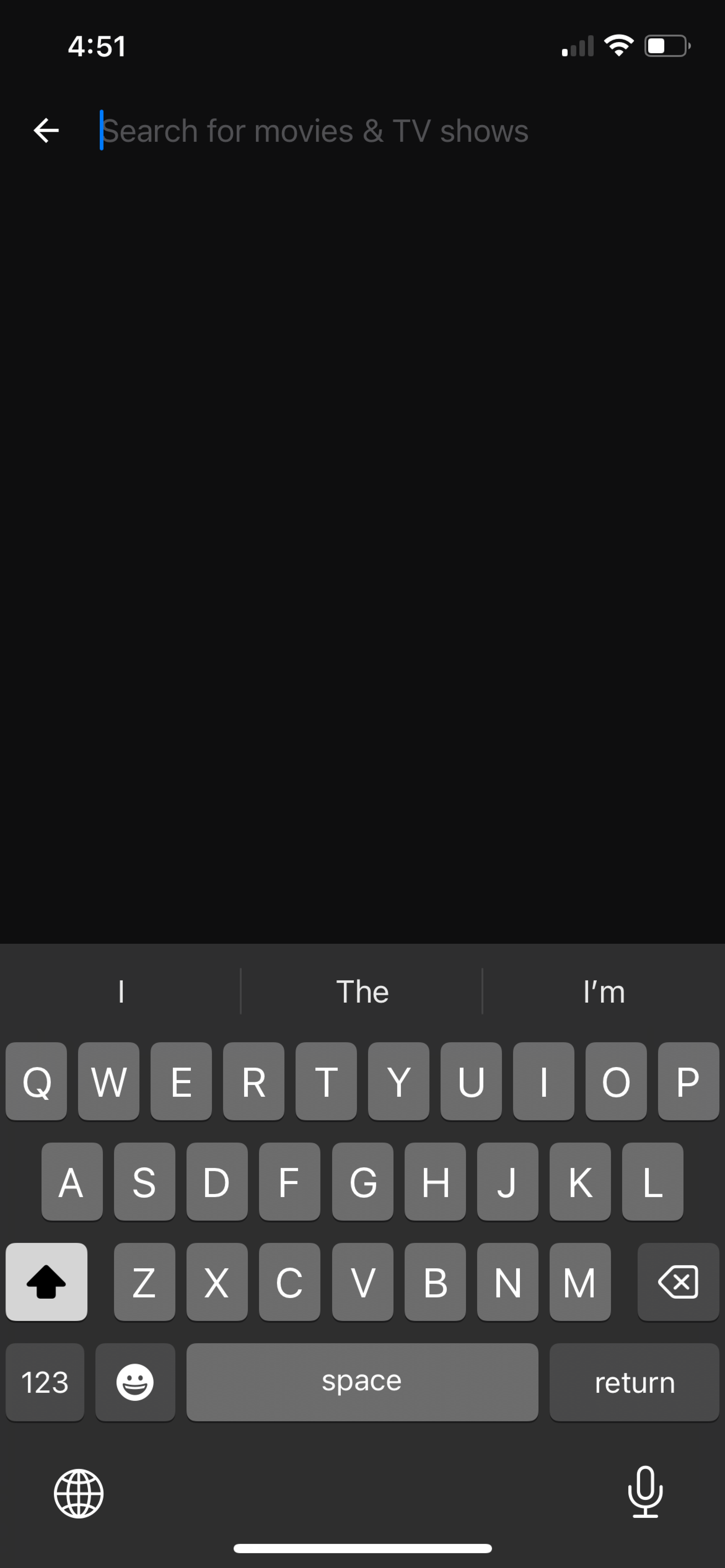
Enhance the Smart TV User Experience
Project Goal:
Improve the primary interaction modes with the Smart TV to enhance user’s navigation experience
The Team
Margarita Khan, Min Ji Kim, Xinyi Hu, Yee Kwan Lim
My Role
UX Researcher, UX designer
Duration
May 2024 to Aug 2024
Introduction to Smart TVs
•Smart TVs are now prevalent in households worldwide.
•They come with built-in Internet connectivity and pre-installed apps.
•Provide direct access to popular streaming services without the need for extra cables or remotes
-
Over 80% of households in developed countries have a Smart TV.
-
The average user spends over 3 hours a day on their Smart TV.
Our Hypothesis
We faced issues with navigation and typing. The current main device for navigating a TV is a remote control, which is not accessible and does not facilitate ease of use for all types of users. The system also lacks multimodality and accessibility features.
Initial Research Findings
Existing solutions for Smart TV navigation are either difficult to use or highly expensive.
Despite Smart TVs supporting a variety of input methods, the primary communication device remains the remote control.
This reliance on the remote control presents significant usability barriers, particularly for users with accessibility needs.
Our Hypothesis VS.
Initial Research Findings
Problem Statement
The existing smart TV system presents significant challenges, including limited accessibility and difficulties in navigation using the primary remote control, thereby restricting usability for a broader range of users and those who prefer alternative input methods.
Key Stakeholders
Our target audience includes:
Users aged 25-60 years old.
Project Constraints
Limited resources: budget, tools and data
Time constraints
Limited stakeholder involvement
Validated Assumption
In the United States and Canada (UCAN), 71% prefer smart TVs, while 49% use smartphones. Something similar happens in Europe, the Middle East, and Africa (EMEA), where smart TVs are the most popular choice in 60% of households, with 46% using smartphones.
Over 79% US households have a Smart TV.
Smart TV Users in USA:
54.9 million are Gen Z.
62.1 million are Millennials.
50.8 million are Gen X.
32.4 million are Baby Boomers.
Contextual Inquiry
The first step we took was to conduct a round of contextual inquiry, to understand the real-world context in which users engage with Smart TVs and their Remote Controls, and to identify pain points, and the significant challenges users encountered during their interaction, especially when they type.
We asked all participants to perform the following tasks:
Log into a Streaming Service
Search for a movie
Type a web address
Additional task based on the participant's usual behavior
Takeaways
Typing Experience
Typing on the Smart TV using the remote control was slow and cumbersome.
The small size of the remote buttons
Need to frequently switch between different character sets
Hovering and scrolling through the alphabet could easily cause mistakes
Impact on User Behavior
All participants avoided certain tasks or services that require extensive typing
No participant had customized Smart TV settings, indicating a potential lack of awareness or ease of use in setting up customizations that could improve their experience.
Typing Alternatives
Mobile device integration: using their mobile devices to type whenever it is possible.
Voice input: using voice input over typing.
Other input methods: mini keyboard, touchpad, game controller for more efficient typing
Secondary Research
We looked into the most popular Smart TV brands to analyze their designs by listing out the pros and cons.
We also did comprehensive research about the current available remote apps from these TV brands, analyzing the look of each app, the pros and cons, and the feedback from consumers
-
Affordable:
Advanced features at lower prices.
Multiple Smart Options:
Choice of Android TV, Fire TV, Google TV, Roku TV, VIDAA U.TV and Xumo TV.
Advanced Picture Tech:
High-quality display technologies at competitive prices.
Innovative Features:
Keeping up with trends in AI, smart features, and gaming.
-
Recommended
Recommended words are provided based on the characters entered by the user. Recommended words are provided by the system by default.On-screen Keyboard
The user may select buttons to enter the corresponding characters.Input Window
An input window should be displayed in an area where the on-screen keyboard does not overlap it. The input window should be adjusted to ensure that no part of it is hidden.Samsung Remote and SmartThings Remote App
-
Universal Remote with keypad
Intelligent Voice Recognition
Intuitive Mouse Like Pointing
Click wheel like a mouse to scroll
Dedicated buttons for Netflix
Access Google Assistant or Alexa
-
Sony Bravia TV & Remote App
Easy to connect to the TV
Good interface
Can do whatever the physical remote can do
Easy to cast content from the phone and mirror your phone screen onto the TV screen.
-
Works in Apply Ecosystem
FaceTime on TV
Apple TV app
Watch, rent, or buy shows and movies
No need to create new accounts for up to 6 family members
Apple TV+
Watch originals
Apple Fitness+
Shows your vitals on your screen
Apple Music
Photos app
Various accessibility settings
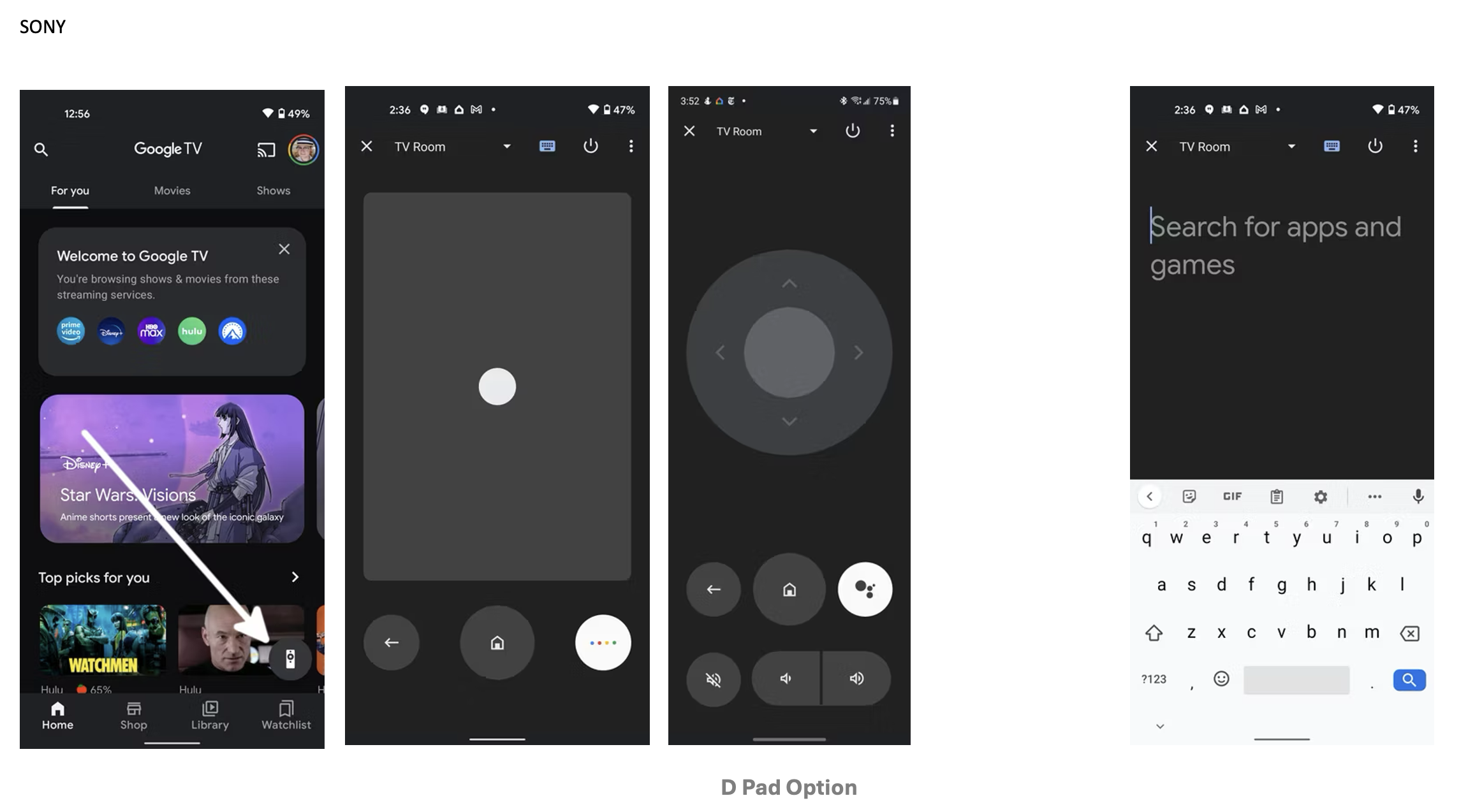
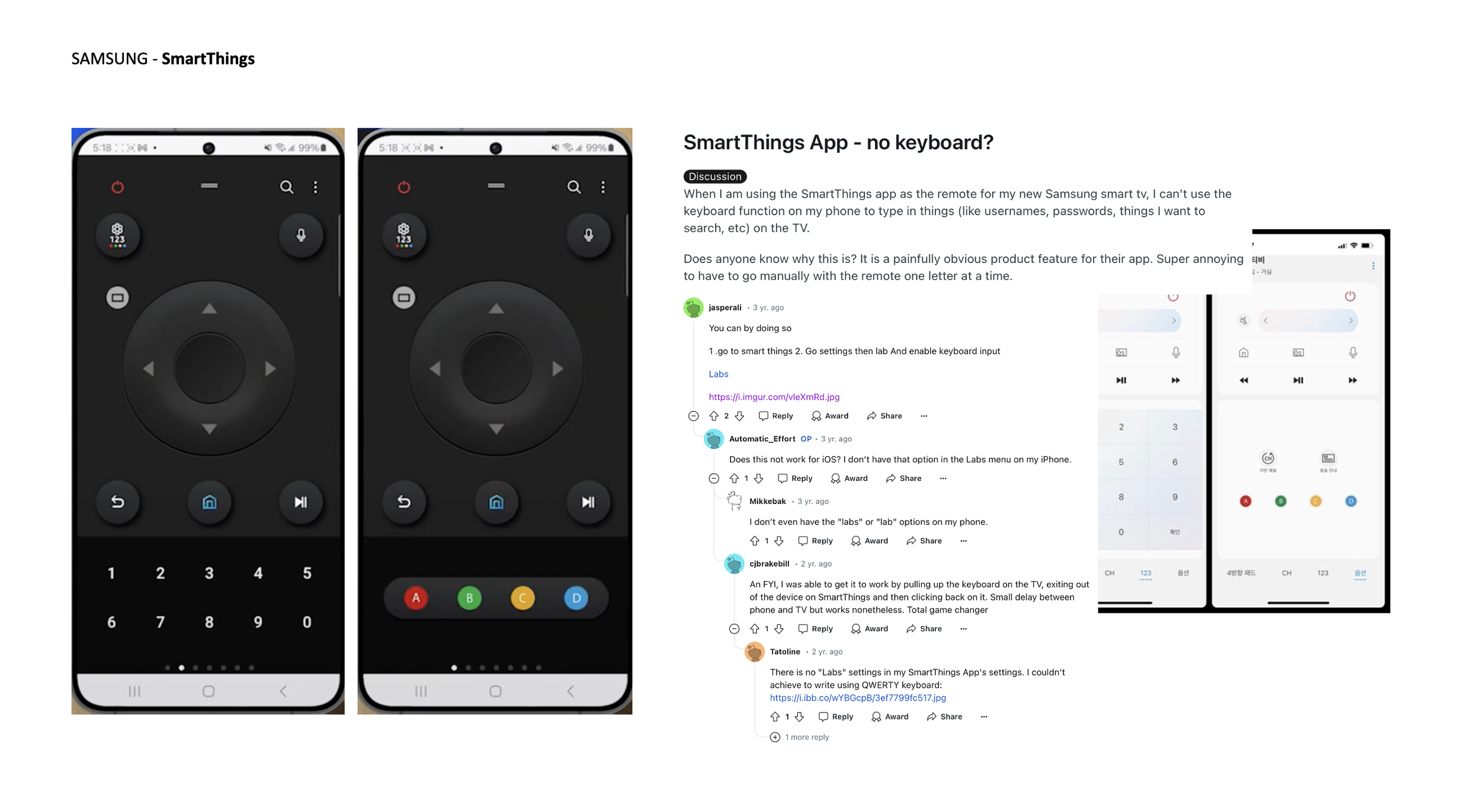
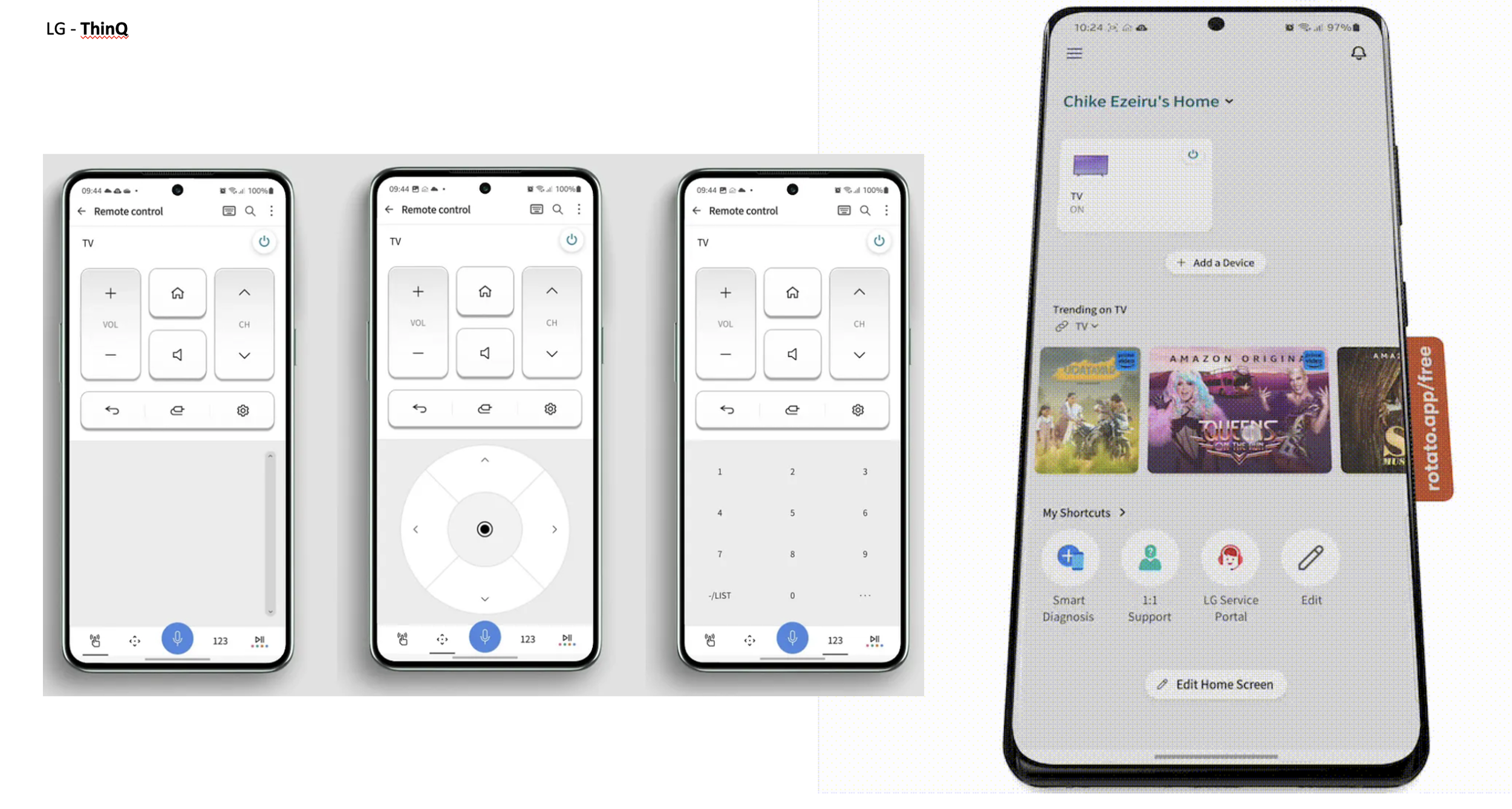
User Journey Map
Opportunities:
Integrate typing assistant functions for easier navigation
Improve the keyboard interface to prevent typos or unnecessary steps
Add voice search/assistant for better search experiences
Ensure intuitive control during interaction
To summarize, we decided to move away from Remote Control and focus on improving the current Mobile TV app design. We created this user journey map to identify different touchpoints and analyze pain points and opportunities we learned from our primary & secondary research.
With an emphasis on improving the current typing features, we want to look at the overall navigation experience and brainstorm for possible design solutions.
HMW Statement
How might we improve the navigation experience for Smart TV users so that users experience seamless cross-device interaction between Smart TVs and Smart Phones?
People who have smart TVs are also likely to have a smart phone. In 2023, about 92% of adults own a smartphone, while 71% of adults own a smart TV.
Given the high rate of smartphone ownership, it's likely that a substantial proportion of households possess both devices.
Design Recommendations
Improve the current Google TV Mobile app so that it acts as a remote control that fulfills navigation needs when using a Smart TV.
Re-design the Google TV Mobile App because:
Compatible with a lot of Android TV devices despite what TV you have in your house.
Google offers swiping pad and optional D-pad just like other apps, and the default controls offer swipe-based navigation that's pretty easy to use.
Minimalistic and sleek design very intuitive yet essential button layouts.
When you select or enter a text field, Gboard opens so you can type.
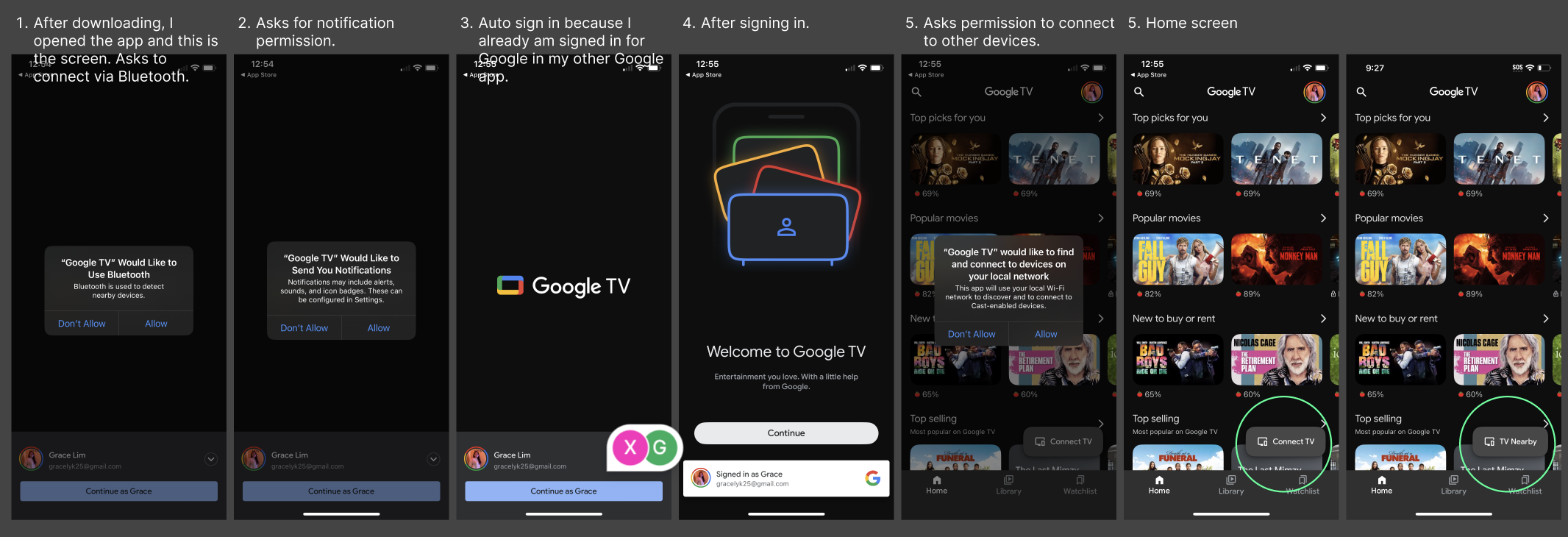

Design Solution Recommendations
Based on the POVs and HMWs, we prepared 7 design recommendations to improve the current Google TV mobile app.
Solution Recommendation 1
Bring up the remote control functions. As for viewing movies and TV shows, users can click on the Library tab.
Add both light and dark modes due to accessibility concerns
Solution Recommendation 2
Add a Miniplayer at the bottom of the screen, so users can access some functions while browsing the library.
Before
After
Solution Recommendation 3
Add functionalities:
-10 +10 sec buttons
Info button
Remote controller shortcut
Slider for Volume
Subtitles
Info Button
Callout to the Platform of Movie
Before
After
Solution Recommendation 4
Add functionalities:
Direction buttons are lower, for easier access to thumbs
Sliding volume bar
The voice icon is more literal
Bigger power button
Slide to pad view
Solution Recommendation 5
Add keyboard functionalities:
Autocomplete drop-down menu
Highlighted ”Back” and “Enter” buttons
The predictive text layout changed
Before
After
Solution Recommendation 6
Save frequently used phrase in users’ profiles:
personalize recommended content
auto-populate relevant search results
Before
After
Solution Recommendation 7
Adjustable keyboard settings to fit different typing preferences and improve typing experience
Before
After
Theories
Contextual Inquiry
Observe people interacting with their Smart TV in their own environment
Understand how users type with Remote Controls and their significant challenges
Gather insights to inform design improvement to enhance navigation
Accessibility
Color contrast: Light and dark mode
Increasing button sizes
Adjustable keyboard settings
Skeuomorphic icon designs to make features more recognizable
Multi-Modality
Input modalities: Remote control, voice and touch on the mobile app
Output modalities: visual, auditory, and environmental











